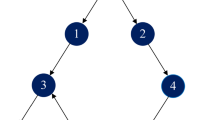Abstract
This paper investigates the problem of output feedback formation tracking control for second-order multi-agent systems under an undirected connected graph and in the presence of dynamic uncertainties and bounded external disturbances. Two state tracking error measures (i.e., absolute and relative state tracking errors) are considered for each individual agent in the formation, and linear reduced-order observers are constructed based on the lumped state tracking errors which include absolute and relative state tracking errors. Chebyshev neural networks are used to approximate unknown nonlinear function in the agent dynamics on-line, and the implementation of the basis functions of Chebyshev neural networks depends only on the desired signals. The smooth projection algorithm is applied to guarantee that the estimated parameters remain in some known bounded sets. Numerical simulations are presented to illustrate the performance of the proposed controller.








Similar content being viewed by others
References
Chung, S.J., Slotine, J.J.E.: Cooperative robot control and concurrent synchronization of Lagrangian systems. IEEE Trans. Robot. 25, 686–700 (2009)
Balch, T., Arkin, R.C.: Behavior-based formation control for multirobot teams. IEEE Trans. Robot. Autom. 14, 926–939 (1998)
Lewis, M.A., Tan, K.-H.: High precision formation control of mobile robots using virtual structures. Auton. Robots 4, 387–403 (1997)
Ogren, P., Egerstedt, M., Hu, X.: A control Lyapunov function approach to multiagent coordination. IEEE Trans. Robot. Autom. 18, 847–851 (2002)
Giulietti, F., Pollini, L., Innocenti, M.: Autonomous formation flight. IEEE Control Syst. 20, 34–44 (2000)
Stilwell, D.J., Bishop, B.E.: Platoons of underwater vehicles. IEEE Control Syst. 20, 45–52 (2000)
Kang, W., Yeh, H.-H.: Coordinated attitude control of multi-satellite systems. Int. J. Robust Nonlinear Control 12, 185–205 (2002)
Carpenter, J.R.: Decentralized control of satellite formations. Int. J. Robust Nonlinear Control 12, 141–161 (2002)
Lawton, J., Beard, R.W.: Synchronized multiple spacecraft rotations. Automatica 38, 1359–1364 (2002)
Ren, W., Beard, R.W.: Decentralized scheme for spacecraft formation flying via the virtual structure approach. J. Guid. Control Dyn. 27, 73–82 (2004)
Ren, W.: Distributed attitude alignment in spacecraft formation flying. Int. J. Adapt. Control Signal Process. 21, 95–113 (2007)
Ren, W.: Distributed cooperative attitude synchronization and tracking for multiple rigid bodies. IEEE Trans. Control Syst. Technol. 18, 383–392 (2010)
VanDyke, M.C., Hall, C.D.: Decentralized coordinated attitude control within a formation of spacecraft. J. Guid. Control Dyn. 29, 1101–1109 (2006)
Changa, I., Park, S.-Y., Choi, K.-H.: Decentralized coordinated attitude control for satellite formation flying via the state-dependent Riccati equation technique. Int. J. Non-Linear Mech. 44, 891–904 (2009)
Abdessameud, A., Tayebi, A.: Attitude synchronization of a group of spacecraft without velocity measurements. IEEE Trans. Autom. Control 54, 2642–2648 (2009)
Scharf, D.P., Hadeagh, F.Y., Ploen, S.R.: A survey of spacecraft formation flying guidance and control. Part II. Control. In: Proceedings of the 2004 American Control Conference, Boston, MA, pp. 2976–2985 (2004)
Hornik, K., Stinchcombe, M., White, H.: Multilayer feedforward networks are universal approximators. Neural Netw. 2, 359–366 (1989)
Sanner, R.M., Slotine, J.J.E.: Gaussian networks for direct adaptive control. IEEE Trans. Neural Netw. 3, 837–863 (1992)
Wang, L.X., Mendel, J.M.: Fuzzy basis function, universal approximation, and orthogonal least-squares learning. IEEE Trans. Neural Netw. 3, 807–814 (1992)
Lee, T.-T., Jeng, J.-T.: The Chebyshev-polynomials-based unified model neural networks for function approximation. IEEE Trans. Syst. Man Cybern., Part B, Cybern. 28, 925–935 (1998)
Patra, J.C., Kot, A.C.: Nonlinear dynamic system identification using Chebyshev functional link artificial neural networks. IEEE Trans. Syst. Man Cybern., Part B, Cybern. 32, 505–511 (2002)
Hou, Z.G., Cheng, L., Tan, M.: Decentralized robust adaptive control for the multiagent system consensus problem using neural networks. IEEE Trans. Syst. Man Cybern., Part B, Cybern. 39, 636–647 (2009)
Cheng, L., Hou, Z.G., Tan, M., Lin, Y., Zhang, W.: Neural-network-based adaptive leader-following control for multiagent systems with uncertainties. IEEE Trans. Neural Netw. 21, 1351–1358 (2010)
Das, A., Lewis, F.L.: Cooperative adaptive control for synchronization of second-order systems with unknown nonlinearities. Int. J. Robust Nonlinear Control 21, 1509–1524 (2011)
Chen, G., Lewis, F.L.: Distributed adaptive tracking control for synchronization of unknown networked Lagrangian systems. IEEE Trans. Syst. Man Cybern., Part B, Cybern. 41, 805–816 (2011)
Dierks, T., Jagannathan, S.: Asymptotic adaptive neural networks tracking control of nonholonomic mobile robot formations. J. Intell. Robot. Syst. 56, 153–176 (2009)
Zou, A.-M., Kumar, K.D., Hou, Z.-G.: Quaternion-based adaptive output feedback attitude control of spacecraft using Chebyshev neural networks. IEEE Trans. Neural Netw. 21, 1457–1471 (2010)
Zou, A.-M., Kumar, K.D., Hou, Z.-G., Liu, X.: Finite-time attitude tracking control for spacecraft using terminal sliding mode and Chebyshev neural network. IEEE Trans. Syst. Man Cybern., Part B, Cybern. 41, 950–963 (2011)
Godsil, C., Royle, G.: Algebraic Graph Theory. Springer, New York (2001)
Teel, A.R.: Adaptive tracking with robust stability. In: The 32nd IEEE Conference on Decision and Control, pp. 570–575 (1993)
Yao, B., Tomizuka, M.: Adaptive robust control of SISO nonlinear systems in a semi-strict feedback form. Automatica 33, 893–900 (1997)
Narendra, K.S., Annaswamy, A.M.: A new adaptive law for robust adaptation without persistent excitation. IEEE Trans. Autom. Control 32, 134–145 (1987)
Author information
Authors and Affiliations
Corresponding author
Rights and permissions
About this article
Cite this article
Zou, AM., Kumar, K.D. Neural network-based adaptive output feedback formation control for multi-agent systems. Nonlinear Dyn 70, 1283–1296 (2012). https://doi.org/10.1007/s11071-012-0533-9
Received:
Accepted:
Published:
Issue Date:
DOI: https://doi.org/10.1007/s11071-012-0533-9



